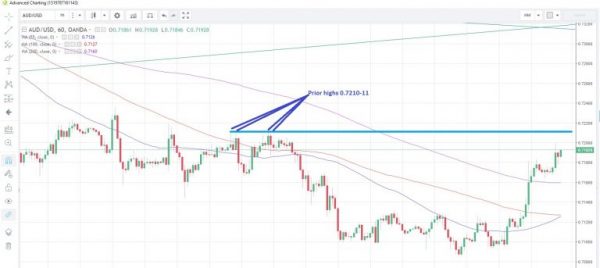Aussie jumped after the economy added more jobs, while the US dollar extended its slide on hopes of more talks at the US-China trade war negotiating table.
Australia labor market remains strong
Australia added a whopping 44,000 jobs in August, the second-highest monthly add in the last nine months. The fact the nearly all of the jobs, 33,700, were in the full-time category is testimony to the positive outlook for the local labor market. Despite a higher participation rate, 65.7% from 65.5%, the unemployment rate remained steady at 5.3%.
Whichever way you slice and dice it, it was a strong report and the knee-jerk reaction in the currency markets was to push the Aussie higher. AUD/USD touched 0.72 (just yesterday it was testing 0.71) before settling back to 0.7190, while AUD/JPY rose to a one-week high of 80.217. AUD/USD faces some immediate resistance from prior highs in the 0.7210-11 window on the hourly charts (four in total) followed by the August low of 0.7238.
No change from the BOE, ECB
Neither of the two central bank meetings today is expected to set the newswires on fire. Since its last meeting, economic data has seen some patchy improvement and the headlines on Brexit have become more favorable. As a result we could hear a more hawkish bias to the accompanying statement from the Bank of England, but markets are still only pricing in chances of a rate hike in the second half of 2019.
The guidance the ECB issued in June, gradual tapering asset purchases by year-end and keeping interest rates on hold through the summer of 2019, is likely to be kept unchanged. There is market talk that the central bank may tweak its 2018 economic forecasts lower as global trade tensions impact demand and change the language of its statement to reflect risks to growth may be tilted to the downside rather than being “broadly balanced”.
US consumer prices on tap
Following on from the weaker August US PPI numbers yesterday (negative for the first time since January), it is now the turn of consumer prices to step forward. Estimates suggest consumer prices rose 2.8% y/y last month, a slower pace than the 2.9% recorded in July, while on a month-on-month basis prices are seen rising 0.3% after 0.2% in July. We hear speeches from Fed’s Quarles (neutral, voter) and Bostic (dove, voter) and these could garner some interest given we are heading to the Fed’s media blackout period from Saturday ahead of the FOMC meeting on the 26th.













